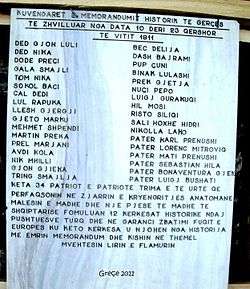Gërçe Memorandum
The Gërçe Memorandum (Albanian: Memorandumi i Greçës[1][2]) of 23 June 1911 included twelve requests for the establishment of an autonomous Albanian province within the Ottoman Empire. The Memorandum was jointly written by Ismail Kemal bey Vlora and Luigj Gurakuqi.[3]


The leaders of the Albanian Revolt of 1911 organized a meeting at the location of Gërçe (Greçë, Gerče, Gerča), in the Kingdom of Montenegro.[4][5][6] It is believed to have been a location in Zatrijebač,[7][8] in modern-day eastern Podgorica municipality. Ismail Qemali joined them and together they draw up the memorandum, sometimes referred to as the "Red Book" because of the color of its covers,[9] which addressed their requests both to Ottoman Empire and Europe (in particular to the Great Britain).[10] This memorandum was signed by 22 Albanian chieftains, four from each tribe of Hoti, Gruda and Shkreli, five from Kastrati, three from Kelmend and two from Shalë.[11]
Requests in the memorandum included:[12]
- General amnesty for all participants in the revolt
- Demand for recognition of the Albanian ethnicity
- Election of the deputies of Albanian ethnicity for the Ottoman Parliament according to the proportional system
- Albanian language in schools
- Governor and other appointed high officials have to know Albanian language and all other positions in the administration have to be reserved only for people of Albanian ethnicity
- Men who are ethnic Albanians to serve army only in Albania during peacetime
- Confiscated arms to be returned
- All Albanian property damaged by Ottoman troops to be compensated
The Memorandum was submitted to the representatives of Great Powers in Cetinje, Montenegro.[13] It was drafted by Qemali as a reply to amnesty offered by Ottoman military commander Shefqet Turgut Pasha on 18 June.[14][15]
See also
References
- ↑ Kaliopi Naska (1987), Ismail Qemali në Lëvizjen Kombëtare Shqiptare [Ismail Qemali in the Albanian National Movement], Akademia e shkencave e RPS të shqipërisë, Instituti i historisë, p. 96, OCLC 28807917,
Memorandumi i Greçës ose «Libri i kuq», siç u quajt në atë kohë, titullohej «Memorandum mbi vendimet e dha- nuna prej Kuvendit të Përgjithshëm të krerëve shqiptarë në Greçë më 10/23 qershor 1911...
- ↑ Journey to Greçë on the 104 anniversary of the meeting (in Albanian)
- ↑ Ahmet Ersoy; Macie J. Gorny; Vangelis Kechriotis (30 October 2010). Modernism: The Creation of Nation States. Central European University Press. p. 235. ISBN 978-963-7326-61-5. Retrieved 13 May 2013.
- ↑ Kacza, Thomas (2007). Zwischen Feudalismus und Stalinismus: albanische Geschichte des 19. und 20. Jahrhunderts. Trafo. p. 46. ISBN 978-3-89626-611-8.
Juni auf einer Versammlung in Gerça (Montenegro) verabschiedete.
- ↑ An Outline of the People's Republic of Albania. 8 Nëntori. 1978. p. 30.
The Albanian patriot headed by Ismail Qemal and a new figure, which w making a name in the movement, Luigj Gurakuqi (187! -1925), gathered at Gerca in Montenegro on June 2! 1911, sent a memorandum to the Turkish Governmea ...
- ↑ Gawrych 2006, p. 186
On 23 June 1911, the Albanians gathered in the small village in Montenegro and drafted the Gerche Memorandum, also known as The Red Book.
- ↑ Tirana (Albania). Universiteti Shtetëror. Instituti i Historisë e Gjuhësisë. Historia e Shqipërisë. p. 318.
- ↑ Abas Ermenji (1996). Vendi që zë Skënderbeu në historinë e Shqipërisë. Çabej. p. 295.
- ↑ Skendi, Stavro (1967). The Albanian national awakening, 1878–1912. Princeton University Press. p. 417. Retrieved 10 October 2011.
The Gerche memorandum, referred to often as "The Red Book" because of the color of its covers
- ↑ Treadway 1983, p. 78
- ↑ Gawrych 2006, p. 187
Twenty two Albanians signed the memorandum, including four each from the fises of Grude, Hoti and Skrel; five from Kastrati; three from Klement, and two from Shale
- ↑ Gawrych 2006, p. 187
The demands included a guarantee of immunity from punishment for all Albanians, the recognition of "the national existence of Albanians",... selecting Albanian deputies ...according to the principle of proportional representation...Albanian language in ... schools, ...
- ↑ Mikić, Đorđe (1983). Austro-Ugarska i Mladoturci: 1908-1912. Institut za istoriju u Banjaluci. p. 273.
У исто време су Албанци емигранти у Црној Гори, на челу са Исмаилом Кемалом и Луибијем Гуракућијем, образложили своје захтеве под називом »Меморандум из Герче« или »Црвена књига« и предали их представницима великих сила на Цетињу.
- ↑ Bartl, Peter (2001) [1995], Albanci : od srednjeg veka do danas (in Serbian), translated by Ljubinka Milenković, Belgrade: Clio, p. 131, ISBN 9788671020176, OCLC 51036121, retrieved 1 February 2012
- ↑ Balkan Studies. The Institute. 1967. p. 41.
Sources
- Treadway, John D (1983), "The Malissori Uprising of 1911", The Falcon and Eagle: Montenegro and Austria-Hungary, 1908–1914, West Lafayette, Ind.: Purdue University Press, ISBN 978-0-911198-65-2, OCLC 9299144, retrieved 10 October 2011
- Gawrych, George Walter (2006), The crescent and the eagle: Ottoman rule, Islam and the Albanians, 1874–1913, London: I.B. Tauris, ISBN 1-84511-287-3